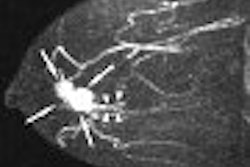BOSTON - Many gastroenterologists are uncomfortable with radiologists' practice of generally leaving medium-sized colonic polyps in the patient unless they grow larger than 10 mm. The studies, though few, suggest that the risks of surveillance may be acceptably low, and virtual colonoscopy researchers are conducting new studies to find out more.
Gastroenterologists wonder if surveillance is safe. But of course there's more at stake than a scientific question. The answer impacts on the very practice of virtual colonoscopy screening.
When it comes to gastroenterologists and radiologists, economic self-interest is never far from the debate though it should be, according to Dr. David Ransohoff, a gastroenterologist and professor of medicine and epidemiology at the University of North Carolina at Chapel Hill.
There is no disagreement that polyps 1 cm and larger detected at VC should prompt a workup, he said. But what about 6- to 9-mm polyps? At what size should these patients be referrred for colonoscopy and polypectomy?
Virtual colonoscopy would be unacceptably expensive if it resulted in too many referrals for polypectomy, Ransohoff noted in a presentation Monday at the International Symposium on Virtual Colonoscopy.
Maybe there isn't enough information to determine a polyp cutoff size yet, he said. But in any case the determination of appropriate referral sizes should be left to those without an economic horse in the race.
Ransohoff said as much in a 2005 pro and con editorial, in which he argued that polyps smaller than 1 mm need not be removed immediately (American Journal of Gastroenterology, September 2005, Vol. 100:9, pp. 1905-1907).
A recent gastroenterology-led update on surveillance standards allows for surveillance of one to two medium-sized polyps, while fretting over the shift of resources away from screening and into surveillance. A radiology-led reporting standards proposal gives patients an informed choice about referral for some medium-sized lesions (CA, A Cancer Journal for Clinicians, May-June 2006, Vol. 56:3, pp. 143-159; Radiology, July 2005, Vol. 236:1, pp. 3-9).
What size colorectal polyp is clinically significant? Is polyp surveillance over time rather than removal a safe approach? If so for what polyp sizes and for how long?
Among people who have VC, 10% were found to have a lesion larger than 10 mm, 35% a lesion over 6 mm, and if patients with small lesions require referral to colonoscopy, VC is inefficient, Ransohoff said. So the question is critical, though data are sparse.
"We do know that small polyps are common," he said. Some 30% to 50% of the U.S. population has an adenoma 10 mm or smaller at least by autopsy studies, less at colonoscopy. But many don't progress; if they did colorectal cancer mortality would be far higher than it is, he said.
There aren't a lot of data on the natural history of polyps, but what there is instructive, Ransohoff said. For instance, Stryker et al reported in 1988 that polyps 10 mm and larger become cancerous at a rate of about 1% per year, high enough to be worrisome, but less than previously thought (Gastroenterology, November 1987, Vol. 93:5, pp. 1009-1013).
Among polyps smaller than 10 mm, a Norwegian study found little evidence of growth. Among lesions 6-9 mm, researchers reported that approximately 0.2% had invasive cancer; 1% at 10 mm had histologically invasive cancer, 4% had high-grade dysplasia. (Gastrointestinal Endoscopy Clinics of North America, July 1997, Vol. 7:3, pp. 345-363).
But having cancer doesn't mean the cancer will cause harm, and the experience in mammography and prostate cancer both suggest that many cancers never progress enough to harm the patient. At the same time it's well-known that treating cancer can harm the patient.
The main finding of the National Polyp Study, with a database of 3,371 adenomas from 1,867 patients who underwent postpolypectomy surveillance, turned out to be the extremely low rate of colorectal cancers found in the cohort, Ransohoff said. Five asymptomatic early-stage colorectal cancers were detected by colonoscopy, including three at three years, one at six years, and one at seven years. (New England Journal of Medicine, December 30, 1993, Vol. 329:27, pp. 2028-2029).
"So risk can be overestimated, and we can be more scared than we need to be," he said. "Is cancer risk and harm overestimated in the question we're considering? I don't know the answer, but at least we have to think about this."
Who decides?
A question more germane to the discussion of surveillance, procedures, and cutoff sizes might be to ask what forces are acting on the decision given the competition for turf and screening dollars. After all, improvements in virtual colonoscopy technique are continually making it a more attractive choice for screening and follow-up.
Ransohoff noted that gastroenterologist Dr. Douglas Rex editorialized that it's problematic to permit any discussion of optimal cutoff size in (virtual colonoscopy) to be driven by notions of which size would make the procedure cost-effective.
This is true, Ransohoff said, but on the other hand, "I also think the radiologist can say it's problematic for the decision to be driven by notions of which size will make (VC) cost-ineffective," he said. "And I think we need to consider how much is economics driving this decision -- and I don't know but I worry."
How would the decision on polyp cutoff sizes look if they were made in a completely neutral environment? Would it be different? What if the VC/colonoscopy debate were decided by a group such as the U.S. Preventive Services Task Force, a body "dominated by generalists and methodologists as opposed to gastroenterologists or radiologists or other subspecialists," Ransohoff said.
The task force's evaluation process is thorough, detailed, very transparent, and importantly neutral, he said. "And I am very wedded to the idea of having this kind of squeaky clean and neutral judge in the process...."
But there's reason to worry, Ransohoff noted. Right around the time Pickhardt et al were publishing a study favoring virtual colonoscopy, a national newspaper ad campaign sponsored by the American College of Gastroenterology warned readers not to trust colorectal cancer screening to just any test, because "your golden years deserve the gold standard of colon cancer screening" -- that is, colonoscopy.
"It's not a coincidence that that happened," he said, nor is the example isolated.
There's a larger context to the decision about polyp cutoff sizes, Ransohoff said, and wisdom to be found in the words of Louis Brandeis, who served from 1916 to 1939 as an associate justice of the U.S. Supreme Court. Brandeis said that society grants professions the right to control their membership if they put their clients' interests ahead of those of the profession. So in that vein, are the medical professions putting patients' interests ahead of everything else?
"We've got to ask if economic self-interest may be distorting -- I'm saying may -- the (polyp size cutoff) decision, and I think we need to keep this in mind."
It's not just about gastroenterologists and radiologists, he said. Being aggressive about screening and therapy is a default in medicine, there's no negative feedback in the system and there needs to be.
At a minimum, decision-makers need to be aware of the forces shaping the screening debate lest they be swayed by arguments that do not primarily serve the patient, Ransohoff suggested.
In the example of prostate cancer, it's well-known that 50% to 80% of men have it when they die, though few die from it. Progression is poorly understood while the harms stemming from treatment are also well-known -- impotence and incontinence even in double digits. But again there is little negative feedback, even, apparently from the men who suffer the side effects. One researcher found that despite the patients' new disabilities, 89% said they'd be treated again, knowing that the cancer had been found and removed, Ransohoff said.
In breast cancer screening, questions have been raised about the natural history and clinical significance of ductal carcinoma in situ (DCIS) warrant the aggressive treatment that is often administered.
"Being aggressive for many things we do in medicine is sort of the default position, it's easy and there's positive feedback. We need to understand as a profession these kinds of forces.... This kind of aggression could -- and should not -- affect the decision about polyp cutoff sizes."
To revisit the U.S. Supreme Court, Chief Justice John Roberts had a great idea when he said that not deciding some questions meant making a decision not to decide, Ransohoff said. Likewise, medicine may be in a position where it cannot and therefore should not decide the optimal cutoff size for polyps while waiting for more evidence on their natural history.
The decision should be made, when sufficient data are available, by a body of generalists and methodologists rather than vested interests in a process that is transparent, thorough, and "squeaky clean," he said.
Ransohoff said his personal opinion (emphasizing the personal) was that the vast majority of polyps 6-9 mm can't cause substantial harm, though some may.
"But if we declare now that 6-9 mm polyps must be immediately removed we're never going to get the data," he said. "And we will have lost information about the natural history that will be critically important."
So let Pickhardt and others study the natural history of polyps 6-9 mm in post-VC surveillance, while technology keeps evolving, Ransohoff said. And when the time comes to make decisions about polyp surveillance and cutoff sizes, they should be based on the interests of patients and the highest technical standards.
By Eric Barnes
AuntMinnie.com staff writer
October 17, 2006
Related Reading
VC finds early niche in screening, September 27, 2006
VC finds risky polyps, might reduce polypectomies, June 8, 2006
Gastroenterologist surveys target lesions, VC practice, March 20, 2006
VC would raise screening costs, study concludes, October 31, 2005
Copyright © 2006 AuntMinnie.com



















